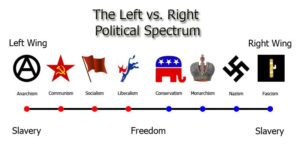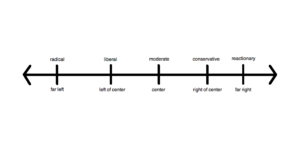 It’s not uncommon for members of the Republican Party—particularly those that identify as MAGA Republicans—to refer to themselves as “conservatives.” In fact, in almost every Republican primary race, candidates go to great lengths to show how far right they are on the political spectrum to convince voters that they are the most conservative of all the candidates. The problem with this scenario is that candidates often move so far right that they cease to be conservative.
It’s not uncommon for members of the Republican Party—particularly those that identify as MAGA Republicans—to refer to themselves as “conservatives.” In fact, in almost every Republican primary race, candidates go to great lengths to show how far right they are on the political spectrum to convince voters that they are the most conservative of all the candidates. The problem with this scenario is that candidates often move so far right that they cease to be conservative.
For most Americans, we view political ideologies in the context of our history and democracy. Today, we associate Democrats with being liberal and Republicans with being conservative. However, when we view the political beliefs of our politicians through a larger, more historical lens, it becomes clear that many Republicans have abandoned conservatism and have instead embraced authoritarian and fascist ideologies.
To fully understand how we use the term “conservative” incorrectly, let’s start from a big picture view and then zoom in on what Republicans in the United States believe today.
Let’s consider the various political systems on a continuum. This is a very basic way to view political systems. Many academics have proposed different ways to compare the various political systems, and many can get incredibly complicated. But for the sake of this conversation, a basic way of viewing political systems should suffice.

Viewing the graphic above, you see that to the far left is Anarchy, and moving right we have Communism, Socialism, Democracy (illustrated by a donkey and an elephant signifying Democrats and Republicans), Monarchy, Nazism, and to the far right, Fascism. You’ll note that Democracy is in the center of the continuum, and the farther you move either left or right, the fewer rights individuals have and the more powerful the government becomes.
One thing I quibble with on the graphic is the placement of Monarchy. We are no longer creating monarchies, so its placement on the chart tends to confuse the issue. If Republicans move farther right, they do not enter into Monarchy territory. That’s not the next step right. Even so, since monarchies do exist in the world, I suppose it is technically correct.
Next, let’s zero in on our American democracy. On the following continuum, you’ll note that to the left of the graphic is Radical (far left), Liberal (left of center), Moderate (center) Conservative (right of center), and Reactionary (far right). Generally speaking, this is how we view political ideology in the United States. However, in recent years, the term “conservative” has been expanded to include values and beliefs that were never part of conservative ideology. In fact, many of the things so-called “conservatives” stand for today are anathema to what American conservatives have long believed.

American conservatism is based in large part on the writings of Edmund Burke, an 18th century Irish author, economist, and political philosopher. Burke was opposed to the unrestrained power of the monarchy in Great Britain and believed political parties were necessary to prevent abuses by the monarch or the government. He believed in the lessons of experience and in gradually improving through tried and tested arrangements rather than in a priori reasoning and fast-moving revolution.
Ronald Reagan is credited with revitalizing the conservative movement in the United States. The American conservative movement stood for individual freedom, limited government, the rule of law, peace through strength, fiscal responsibility, and free markets. Above all, American conservatives believed in the primacy of our democracy, the sanctity of the Constitution, and the inalienable rights of all citizens.
It’s worth noting that in hindsight, conservatives didn’t always act in ways that were in line with their declared belief in these principles. Nevertheless, these principles were the foundation of conservative belief.
Through the post-war era of the 1940s, into the 1950s, 1960s, 1970s, and 1980s, the Republican and Democratic Parties both had members that were liberal, moderate, and conservative. At the time, there was no absolute linkage between liberal-Democrat and conservative-Republican. That began to change in the 1990s, particularly with the rise of the Tea Party movement.
Today, the Democratic Party consists of moderate and liberal members, and Republican Party members proudly self-identify as “conservative.” However, the policy positions of the leaders (and many members) of the Republican Party are far out-of-step with the principles traditionally associated with conservatives.
For instance, rather than advocating for individual freedom, today’s MAGA Republicans push for a rolling back of individual rights. In recent years, Republicans have almost universally advocated for the suppression of voting rights, the repeal of a woman’s right to have an abortion, and many Republicans are pushing for a repeal of same-sex marriage and the right to contraception. Until recent years, we saw an expansion of rights for American citizens. But for the first time in our country’s history, we see a major political party working to deny American’s their hard-earned rights.
Republicans over the past eight years have espoused a commitment to the rule of law, even while fighting against the use of the legal system against their leaders. You don’t have to look any further than the four indictments and 91 felony charges against former President Donald Trump to see that most Republicans don’t truly believe in the rule of law. Trump himself views our legal system as a “political witch hunt,” and many of his fellow Republicans claim that government—particularly our federal law enforcement agencies and Department of Justice—are being weaponized against not only the former president, but Republicans writ large, including the January 6 defendants.
Speaking of Trump, he recently laid out his plans for a second term in the White House, and his vision gives a good indication of how far Republicans have moved away from conservativism. Trump promises mass deportations; open air camps at the border for illegal immigrants; a ban on immigrants from “Muslim countries; forced relocation of homeless Americans to tent cities; Implementation of “stop and frisk” laws and deployment of the National Guard to fight crime in our larger cities; pardoning January 6 defendants; a complete overhaul of the government, including firing most career employees and replacing them with loyalists committed to carrying out his wishes; and a Department of Justice that will arrest and imprison his political opponents. As if this wasn’t scary enough, Trump wants to invoke the Insurrection Act on his first day back in office, which will allow him to use the military as a domestic police force, capable of quelling any protests or unrest in response to his draconian policies.
Of course, none of what Trump is planning to do if he wins the presidency is conservative. It certainly spills over into the Reactionary area of the above graphic, and much of what he wants to do goes even farther right on the chart, into fascism. And sadly, many, if not most, Republicans in Congress support the actions Trump wants to take. In recent weeks, Senators such as Ron Johnson (R-WI), Mike Lee (R-UT), Ted Cruz (R-TX), Tom Cotton (R-AR), as well as several Republican members of the House have shared unfounded conspiracy theories and outright lies that tend to support the actions Trump wants to take as president. These elected Republicans have abandoned conservatism—as well as democracy—in an effort to regain control of the government.
My point is this: the word “conservative has a definition. True conservatives have well-defined values and political beliefs. Those values and beliefs may change slightly over time, but they remain basically the same. We do a disservice to our fellow citizens when we misuse words like “conservative.” Trump and his supporters are, at best, reactionaries, and many qualify as authoritarians and fascists. We shouldn’t redefine words to fit the actions being taken by MAGA Republicans. Instead, we should use the words that already exist and the definitions that already describe what Trump and his followers are and what they plan to do.
